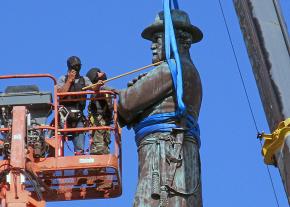They don’t belong in a museum either
With many Southern cities taking down public monuments to the Confederacy, Brooklyn museum worker says he doesn't want them where he works either.
"CONFEDERATE STATUES don't belong in public. They should be removed from public places and put where they belong, in a museum."
Over the past week, I've heard this argument being used in what, in my most generous reading, is an attempt to reconcile the demand for the removal of the statues with a belief in preserving history and in the important role that museums play in preserving the past and interpreting it for the present.
In a less generous reading, this argument presupposes museums as a place to put away and forget, or doom to irrelevance, the objects that are placed there.
Or perhaps museums are places that reflect our desires as a society and culture? In this case, there are two reasons for putting Confederate monuments constructed in heroic proportions in museums: one, because they are reflections of the kind of world we want to live in; or two, because in museums, they can be contextualized, their message interpreted and used as a warning to future generations.
But can you imagine the audience for a museum that contained Confederate statues?

Ultimately, the Confederate States of America was an attempt to found a nation-state on the ideology of white supremacy. As all unnecessary deaths are tragic, the many unnecessary deaths caused by the Civil War should be commemorated. When wars are fought, it is the blood of the poor of every color that is shed.
But not all the deaths in the Civil War were unnecessary. The white men who seceded from the nation and declared war when their right to be barbaric toward other humans and become wealthy off of torture was threatened did not need to be spared.
It was a minimum condition of justice for the millions enslaved, murdered and brutalized by the regime of white supremacy for hundreds of years that the cause of slavery was destroyed by the means necessary to achieve that end.
Is not the basis of fascism an extremist racist ideology? It is then no surprise that white supremacists chose these monuments to rally around. To put these monuments in a museum would only serve to reify their status as white supremacist idolatry.
Considering the active nature of this struggle, to preserve the monuments in any fashion can only serve the interests that led to them being erected, mainly in the early 20th century, in the first place: white supremacy, racist terror and violence towards the oppressed.
Finally, this argument presumes that museums are not, in fact, public spaces. Museums absolutely are public places--they are places meant to be open to all.
No amount of interpretation can change the meaning of these statues. They must be removed--and, ideally, replaced with monuments to the enslaved and oppressed who persevered and ultimately ended the institution of slavery.
It is true that the monuments will be in museums. Hundreds of years from now, pictures of their toppling will be included in histories of the U.S. Civil War--and of how the battle to defeat the slave power once and for all was waged well into the 21st century.


